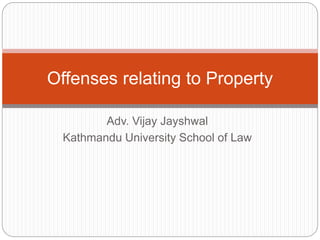This document discusses various laws related to property offenses in Nepal. It begins by introducing the concept of theft and its elements under common law. It then discusses various theories of property law such as bundle theory, exclusion theories, use theories, and others. The document also discusses rational choice theory, routine activity theory, elements of a suitable target, absence of guardianship, and presence of likely offenders. It provides details on specific property offenses under Nepalese law such as theft, burglary, robbery, dacoity, and related punishments. The document also covers offenses relating to documents, cheating, criminal breach of trust, extortion, and pickpocketing.











![Theft
The old has divided the offenses of theft into five categories:-
cfkmgf]xsgk'Ug] crne}/x]sf]nfO{rnsf]lx;fau/fO{jf rnwgdfn ;d]txsk'Ug] wgLnfO{yfxfglbO{jf
p;sf]dGh"/LgnLwgLsf]xsd]6fO{cfkm"n]lngf vfgfsfnflu h'g;'s}s'/f]u/La]OdfgLsflgotn]
s;}n]nUof]eg] rf]/Lu/]sf]7x5{.
a. Simple theft (No. 1,2,12,13, 27)
b. Burglary (No.3, 14(1) v'nf 9f]sfaf6afx]s;]g jf;'?Ë vgLjf leQf ‰ofn9f]sfx?kmf]/L
jf vf]nLjf 5fgfsf}zL‰ofnk/vfn OToflbu}x|caf6f]af6s'g} t/xn]leqk;Lrf]/Lu/]sf]jf leqk:bf
af6}af6k;]sf]ePklglg:sbf ;f]n]lvPsflsl;daf6aflx/lg:s]sf]eP gsahgLu/]sf]7x5{
c. Theft with use of force (No.4, 14 (2) rf]/Lubf{s'6kL6xftkftu/Ljf afFwLlyrL
jf plQv]/}Hofglng] jf lhp hvd cËeË ug]{8/ qf;u/fO{jf leqa;]sf]dflg;lg:sg gx'g] u/L9f]sfaGb
u/Lrf]/Lu/]dfjfrf]/Lu/]sf]yfxfkfO{df}s}dfjfbk]6b}uO{dfnlng jfrf]/kqmg vf]Hbfrf]/n]
dflyn]lvPadf]lhdhf]/h'n'du/]dfjf ;f]adf]lhds]xLgu/] klg gfafnssf]lhpsf]wgdfnvf];Lrf]/L
u/]sf]dfhah{:tLrf]/Lu/]sf]7x5{.
d. Robbery (No. 5, 14 (3) af6f]3f6f]jf hËndf9'sLhah{:tLrf]/Lu/]sf]/xhgL7x5{.
e. Dacoit (No.6,14, 4)rf/hgfeGbf a9tfsf]hdfteO{hah{:tLrf]/Ljf /xhgLdfn]lvPsf
/Lt;+ujfxftxltof/lnO{p7fO{5f8Ljfx'nx'Hhtu/Lrf]/Lu/]sf]8fFsfu/]sf]7x5{.](https://image.slidesharecdn.com/offensesrelatingtoproperty-190705054713/85/Offenses-relating-to-Property-12-320.jpg)












